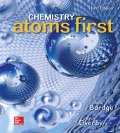
Concept explainers
Interpretation: The wavelength required to break the bond between carbon and bromine atom with given minimum energy requires for breaking the bond and the stability of the bond in troposphere and the stratosphere should be determined.
Concept Introduction:
Energy: The energy is conversed property since it can neither be created nor be destroyed but can be transformed. The energy of the photon is obtained by using the following relation
Wavelength: The distance between the two continuous maximum displacements present in wave or the two continuous minimum displacements present in a wave exhibited by the photons is called wavelength. The wavelength of the photon is inversely proportional to its frequency. The relationship between them is given by the following formula,
Frequency: It denotes the number of waves passes in given amount of time.
Atmosphere: The atmosphere is defined as air that is layer of gases which surrounds the earth due to gravity of earth.
The earth atmosphere consists of layers such as thermosphere, mesosphere, stratosphere and troposphere depending on the temperature and its composition.
Stratosphere:
It is found below the mesosphere layer in which the concentration of ozone and other gases are high. The increasing temperature for this layer with respect to increasing height is due to the presence of high concentration of ozone and other gases in it.
The increased temperature is due to the response of UV radiation from sun and hence ozone is formed due to this reaction and the use of ozone is that it prevents the UV radiation from the sun which is actually harmful.
Troposphere:
The layer is below stratosphere layer and it is closest to the earth surface. It is wholly composed of major air that is 80% of the total mass and almost all the water vapor.
It is the thinnest place which is responsible for all weather conditions since it contains almost all amounts of water vapor with it.
To determine: The wavelength required to decompose the given bond and the stability of that species in the given atmospheric layers.
Trending nowThis is a popular solution!

Chapter 21 Solutions
Chemistry: Atoms First
- Explain the difference between the effects of ground- level ozone and stratospheric ozone. Why is one beneficial to human life, whereas the other is not?arrow_forwardWhat is the biological importance of stratospheric ozone? Explain.arrow_forwardIt requires 364 kJ/mol to break the chemical bond in HBr molecules. 1. What is the longest wavelength (in nm) of light that has enough energy to cause this bond to break? 2. Will HBr molecules in the troposphere be fragmented into atoms?arrow_forward
 Chemistry for Engineering StudentsChemistryISBN:9781285199023Author:Lawrence S. Brown, Tom HolmePublisher:Cengage Learning
Chemistry for Engineering StudentsChemistryISBN:9781285199023Author:Lawrence S. Brown, Tom HolmePublisher:Cengage Learning Chemistry & Chemical ReactivityChemistryISBN:9781133949640Author:John C. Kotz, Paul M. Treichel, John Townsend, David TreichelPublisher:Cengage Learning
Chemistry & Chemical ReactivityChemistryISBN:9781133949640Author:John C. Kotz, Paul M. Treichel, John Townsend, David TreichelPublisher:Cengage Learning Chemistry & Chemical ReactivityChemistryISBN:9781337399074Author:John C. Kotz, Paul M. Treichel, John Townsend, David TreichelPublisher:Cengage Learning
Chemistry & Chemical ReactivityChemistryISBN:9781337399074Author:John C. Kotz, Paul M. Treichel, John Townsend, David TreichelPublisher:Cengage Learning Chemistry: The Molecular ScienceChemistryISBN:9781285199047Author:John W. Moore, Conrad L. StanitskiPublisher:Cengage Learning
Chemistry: The Molecular ScienceChemistryISBN:9781285199047Author:John W. Moore, Conrad L. StanitskiPublisher:Cengage Learning Chemistry: Matter and ChangeChemistryISBN:9780078746376Author:Dinah Zike, Laurel Dingrando, Nicholas Hainen, Cheryl WistromPublisher:Glencoe/McGraw-Hill School Pub Co
Chemistry: Matter and ChangeChemistryISBN:9780078746376Author:Dinah Zike, Laurel Dingrando, Nicholas Hainen, Cheryl WistromPublisher:Glencoe/McGraw-Hill School Pub Co





